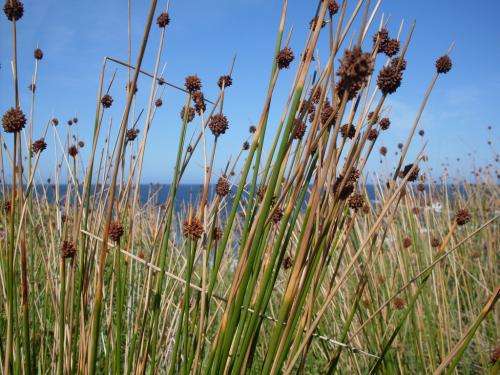X-rays help map seed's salt tolerance

Researchers have used flame photometry and electron microscopy's full-spectrum X-ray mapping to reveal differences in salt uptake and distribution in the seeds of WA coastal plants.
The work looked at salt-tolerant Ficinia nodosa (Cyperaceae) and salt-sensitive Spyridium globulosum (Rhamnaceae), which are common in South-West coastal Holocene dune communities.
Biologist Lydia Guja says the research focussed on how exclusion or localisation of sodium chloride within germinating seeds might affect salt tolerance, an area for which little empirical data has been collected.
"How seeds are able to survive and germinate following exposure to salt is a question that has been considered since Darwin's first experiments examining the possibility of long-distance dispersal of seeds via the ocean," Ms Guja says.
"Seeds of many coastal plants can survive exposure to seawater for weeks or even months.
"Their salt tolerance or avoidance strategies are poorly understood, even though these traits may fundamentally influence dispersal and recruitment in coastal dunes."
Researchers found salt-resistant F. nodosa excluded sodium, as expected, but were surprised chlorine was moving through the seed embryo at low concentrations.
When the seeds were exposed to high concentrations of sodium chloride or exposed for extended periods, chlorine was compartmentalised in the endosperm.
Conversely, seeds of the salt-sensitive S. globulosum absorbed sodium and chlorine and did not appear to have a compartmentalising mechanism.
While the seeds could tolerate sodium chloride at lower concentrations, or for short durations, greater exposure and accumulation in the growing embryo led to potassium displacement and ion toxicity.
"Over the first week, at low external sodium chloride concentrations, sodium entered seeds with no localisation to specific internal tissues," Ms Guja says.
"At 750 millimoles sodium chloride, sodium appeared localised to the inner edge of the seed coat.
"After 14 or 21 days of water uptake at this level, germination was severely impacted and sodium was approximately four times higher than in dry seeds, with accumulation predominately within the embryo, rather than being distributed through the seed tissues.
"This ultimately led to seed death."
Ms Guja says the study may help inform future seed development.
"The movement of ions between seed tissues during germination has not been researched and future investigations of transport are likely to reveal the detailed mechanics by which seeds are able to tolerate germination in saline conditions," she says.
"Studies of this type will provide a guide for the development of seeds that are resistant to salt during the early stages of germination and will have implications in many fields."
More information: Guja, L., Wuhrer, R., Moran, K., Dixon, K. W., Wardell-Johnson, G. and Merritt, D. J. (2013)," Full spectrum X-ray mapping reveals differential localization of salt in germinating seeds of differing salt tolerance." Botanical Journal of the Linnean Society, 173: 129–142. DOI: 10.1111/boj.12072
Journal information: Botanical Journal of the Linnean Society
Provided by Science Network WA




















